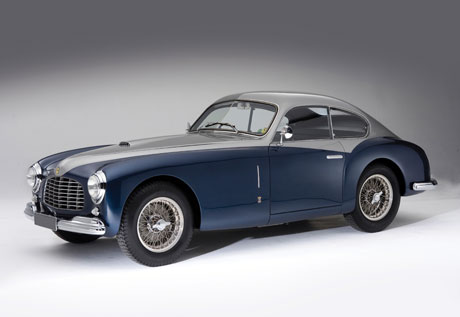SCM Analysis
Detailing
| Vehicle: | 1949 Ferrari 166 Inter Farina |
| Number Produced: | 37 |
| Original List Price: | $9,000 |
| Tune Up Cost: | $2,600 |
| Distributor Caps: | Negotiable, but offer $600 |
| Chassis Number Location: | Front frame tube |
| Engine Number Location: | Engine rear mount |
| Club Info: | Ferrari Club of America PO Box 720597 Atlanta, GA, 30358 |
| Website: | http://www.ferrariclubofamerica.org |
| Investment Grade: | B |
This car sold for $500,910, including buyer’s premium, at RM’s Automobiles of London Auction in England on October 28, 2009.
Earlier, in May 2009, RM offered it at the Maranello sale but it was withdrawn, apparently because Ferrari Classiche wouldn’t certify it, perhaps because of the 212 engine and the modern taillights. The seller had bought it at a Brooks auction in 2000 for $348k.
The value of 166 Inters depends both on physical attractiveness and performance, with the 166 MM Touring Barchettas worth up to $2.5m. These cars defined the Ferrari image: “The 166 MM Touring Barchetta, just 25 built, was the first beautiful Ferrari and fundamental to the brand’s success,” said David Seielstad, an expert and owner of a 166 MM. “Its styling was unlike anything before and has influenced the design of vehicles from the AC Bristol to the latest Ferrari California.” More mundane styles sell for $400k to $1m.
After the 166’s racing success, wealthy customers began to ask Ferrari for a dual-purpose version, and the Inter was developed. It was a heavier car on a longer wheelbase, with one carburetor and lower compression.
Various coachbuilders built bodies with their own interpretations of how a Ferrari should look. Carrozzeria Touring bodied perhaps nine conservative four-window coupes and also produced about ten Berlinettas with rakish fastback styling.
The five Inter coupes bodied by Farina were a sober design that lacked the individuality of the marque, partly because the design was based on the Cisitalia 202 and also used on two previous Fiat 1100 models.
Last Farina coupes had “proper” grilles
The first two coupes, 009S and 021S, had a grille of four horizontal thick slats and an air scoop above the grille, not on the hood. The last two Farina coupes, 037S and 041S, had “proper” Ferrari eggcrate grilles and an air scoop on the hood. The third Farina coupe, 031, had the hood scoop but the earlier grille. It’s been rebodied and lost its original engine/transmission, now having a 212 engine.
The Farina coupes were more sporting than the Touring coupes, and the last two had more of the desirable Ferrari look. So the Farina coupes are mid-range as far as Inter values, and most enthusiasts would consider 037S fairly desirable.
Performance and handling are pretty anemic by today’s standards. An early owner of 031S said, “It might beat an MG TD on a good day, but not a TD Mk II.” Having owned and driven the first and second Farina-bodied 166 Inters, 009S and 011S, and a Ghia-bodied Inter 212 2+2, 0189, bought by King Farouk from the 1952 Brussels show stand, I can attest to the vintage feel of these cars.
One Saturday, nearly 35 years ago, I took the Farouk 2+2 to a car show with the kids in the back. The handling is early ’50s, and combined with the single-carburetor 212 engine of about 120 hp, a non-synchro gearbox, and right-hand drive, it was an exciting trip in modern traffic.
An early owner of the sister car to this, 041S, was Dr. A. Mirkin, who was the Medical Director at the Sebring endurance races from 1951 to 1961. He made several trips from Maryland to Florida in 041S and reminisced about the car in 1996. “Owning and driving that Ferrari was pure joy,” he said.
The new owner can tell Lord Brocket stories
So if you’re not hung up on 0-60 mph times under ten seconds, and can appreciate conservative styling (Publisher Martin once said about 021S, “It has a stylish, baby Bentley R-type Continental look to it.”), it could be a fun car, and a good buy.
And while the Inters were not built to race, they had some track success, so you can envisage yourself in the driver’s seat of 009S-the first Farina coupe-when it came in 3rd at the 1949 Monza GT race.
And the stories you can tell about Lord Brocket must be worth something. Lord Brocket once had over 50 Ferraris and Maseratis, and as the collector markets sank in the early ’90s, he cut up several Ferraris and pickled the components in oil-filled 55-gallon drums in a scheme to collect insurance money.
Ed Niles has owned more than 100 Ferraris in 45 years and has his own Brocket story. Niles bought 037S in October 1986 for $25,000 from an L.A. friend who had owned it for 17 years. The engine was apart and Niles started collecting bits to rebuild it, but before he got too far along, Steve Forristal, a Houston dealer, bought it from him as-is for $33,500.
Niles thinks, but is not sure, that Forristal sold it to Lord Brocket, because Brocket used to call Niles for advice about restoring the car. He would announce himself to the receptionist as “Lord Brocket,” but when Niles came on the line it was, “Hi, it’s Charlie Brocket.” The receptionist was mightily impressed that her boss was getting calls from a peer of the realm-and on a first-name basis. Now the new owner owns an ex-Lord Brocket car, at a fair price, and all the stories that come with it.
